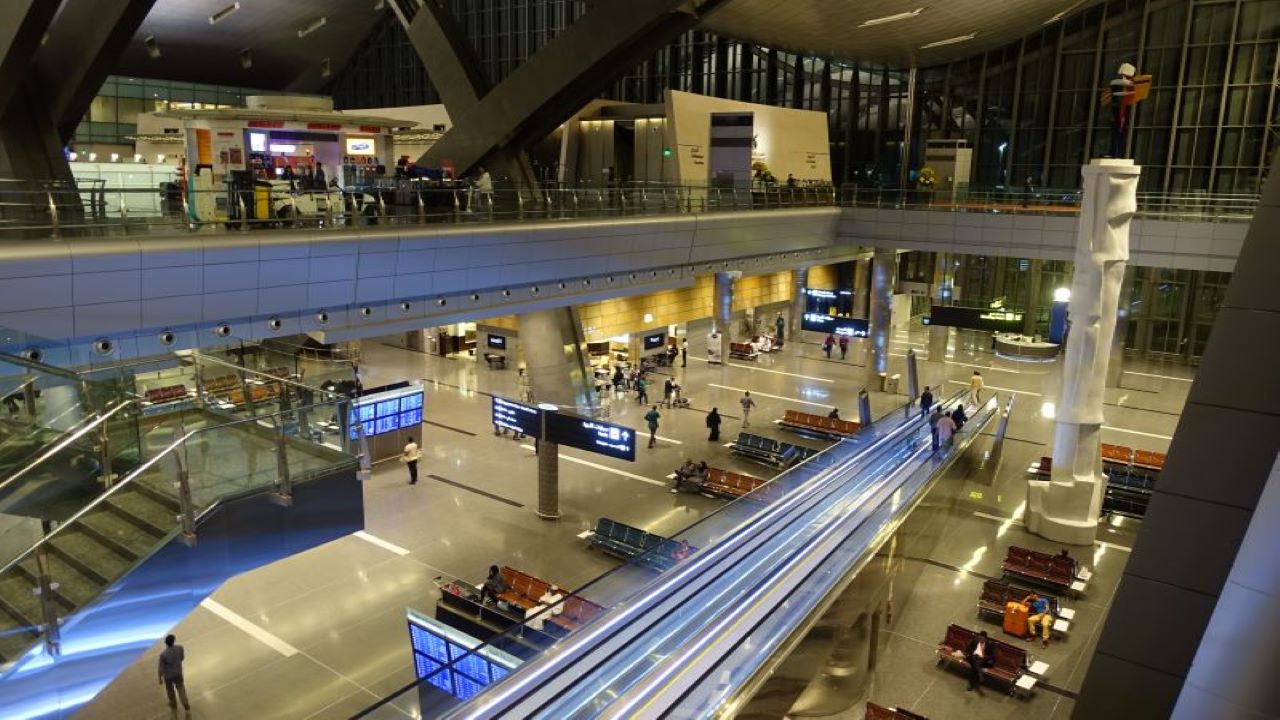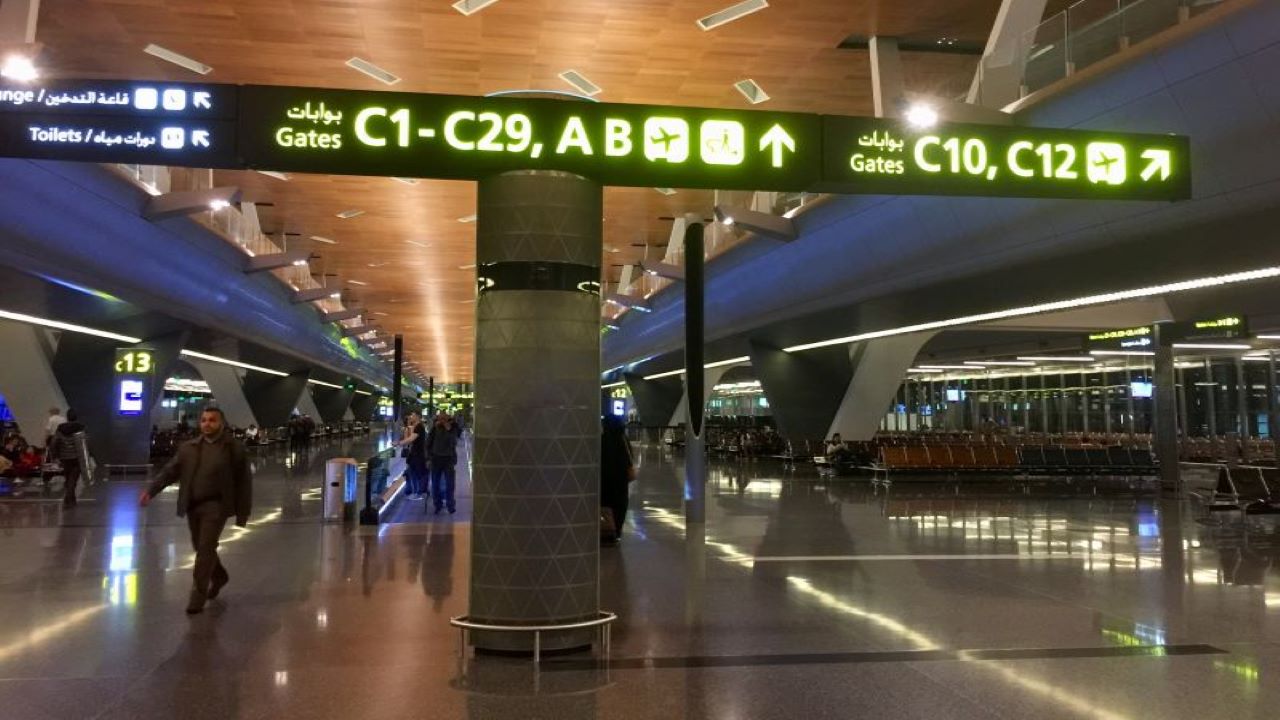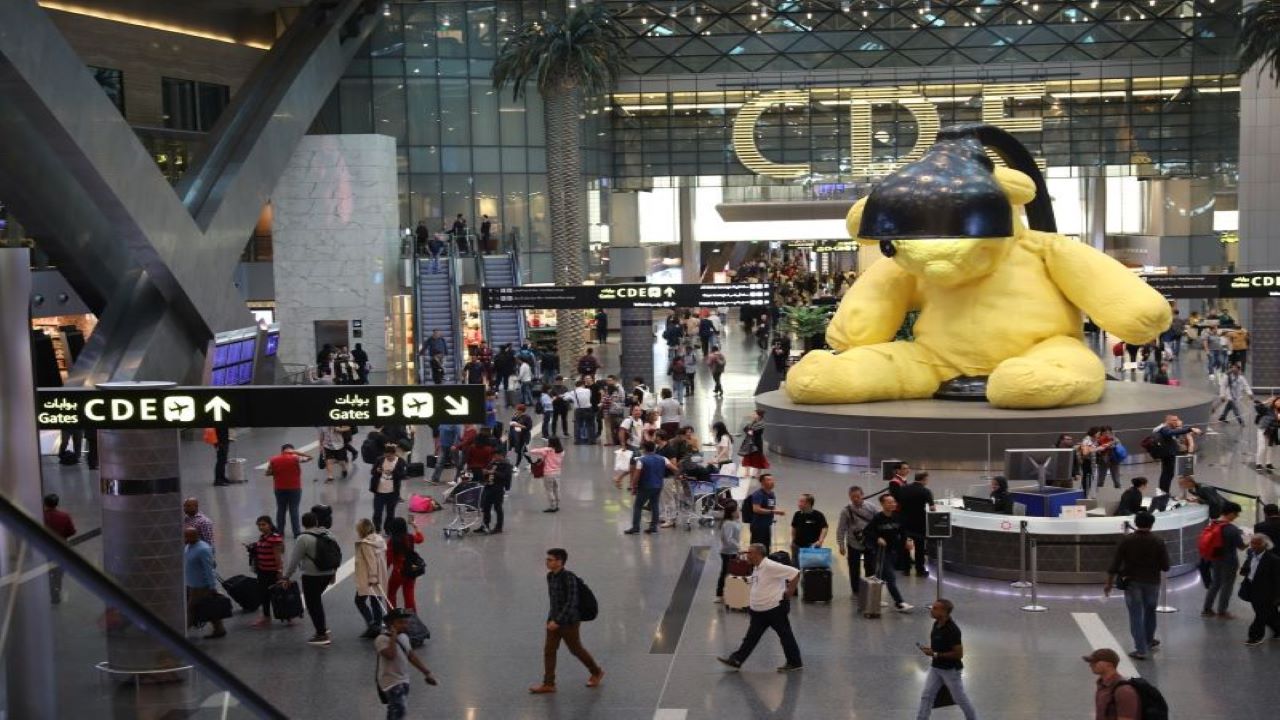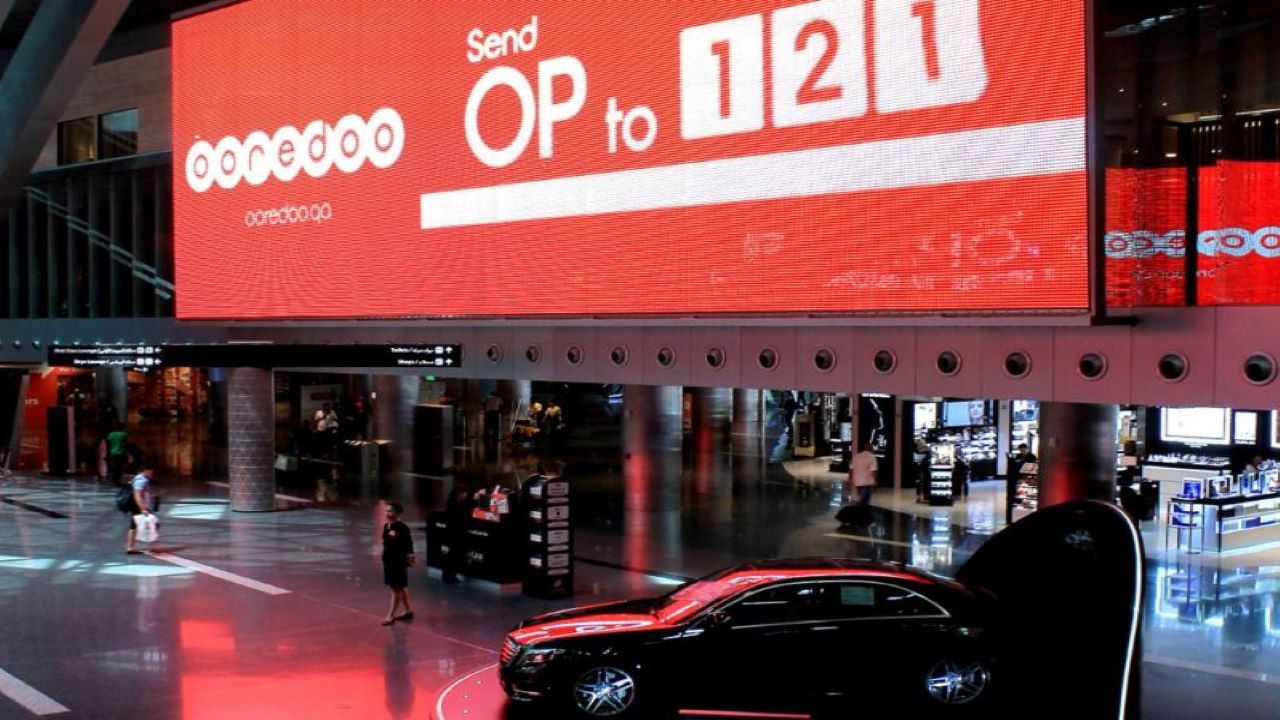Hamad International Airport (HIA) is Qatar’s brand-new airport to replace Doha International Airport, constructed 4km from the existing facility on a 5,400-acre site and Qatar’s only international airport.
Formerly known as the new Doha International Airport, the project was undertaken in response to a projected demand for additional international passenger capacity to the region. The airport handled approximately 38 million passengers in 2019.
Phase one construction was initially scheduled for opening in December 2012 but was postponed and finally inaugurated at the end of April 2014.
The airport was constructed near the city of Doha and is approximately two-thirds the size of the city (12 times larger than the old airport).
The second phase expansion programme, which was revealed in October 2019, aims to further increase the passenger handling capacity to 53 million to accommodate increased passenger numbers during the FIFA World Cup in 2022.
Qatar Civil Aviation Authority (QCAA) and the New Doha International Airport Steering Committee are the bodies in Qatar responsible for the airport development. The Qatar Company for Airports Operation and Management (MATAR) is responsible for airport operation and management.
New Doha International Airport background
The contract for the first phase of the airport construction and the planning and design phase was awarded to Bechtel Group. The project started in early 2004 with a detailed planning and design phase, when Bechtel produced a masterplan of the new airport.
Work continued in 2004 with a massive land reclamation project since more than half of the area of the new airport is being constructed on land reclaimed from the sea, amounting to 10.9 square miles.
The land reclamation required more than 62 million cubic metres of ‘fill’ to be completed (needed four large dredgers to complete the project). The reclamation was completed in early 2005 and the reclaimed area required 13km of armoured seawall to protect the construction. The removal of 6.5 million cubic metres of household waste from a dump to a remote engineered landfill was constructed according to environmental standards.
The new airport features two of the longest commercial runways in the world, an 85m-high control tower, a 600,000m² passenger terminal, one cargo terminal, a 150,000m² aircraft maintenance centre, one separate terminal for the Emir of Qatar, a general aviation terminal, one of the world’s largest airport catering facilities, air traffic control equipment and security systems.
Phase one of Qatar’s brand new airport
The first phase construction of the new airport included two runways 4,850m and 4,250m in length, designed specifically to accommodate the new Airbus A380-800 superjumbo.
During the construction process, the old airport was expanded and refurbished at a cost of $140m. A new dedicated departure facility named Terminal B was opened at the airport in June 2011.
A three-storey terminal building was also constructed, including 350,000m² of floor space, which includes 25,000m² of retail space. In addition, there are seven remote gates and eight hardstand aircraft parking bays.
Three new major road interchanges provide access to the new airport from the city and surrounding areas (the airport itself has 17km of dual-carriageway and single-carriageway roads). To facilitate passengers, the airport has a five-star luxury hotel and a three-star transit hotel.
The complex also includes a centrally located 48,000m² cargo terminal (750,000t/y) with 15m clearance, which is among the 20 largest cargo terminals in the world. There are also hard standing areas for the passenger terminal, an 80m ATC, hangar space for two A380-800s and three A340s, and a 70,000m² maintenance centre with mezzanine levels for access to aircraft top decks.
For the convenience of passengers, there is an automated storage and retrieval system. Major cargo is transported in unit load devices (ULD).
The system has a capacity to accommodate up to 1,000 ULDs. Import cargo consignments and those awaiting loading in the containers are stored in the automated storage system.
The cargo system includes advanced facilities such as high-bay storage areas for import and export of cargo, workstations for make-up and breakdown of ULD loads, storage areas of special cargo such as hazardous materials, valuable items, cold storage, perishable foods and medicines.
Central maintenance hub for Qatar Airways
HIA is the central maintenance hub for Qatar Airways’ international fleet. Located in the midfield area, it is capable of handling up to eight wide-body aircraft, including A380s and 11 aircraft.
The base features a single large hangar containing heavy and light maintenance bays. The column-free design of the hangar’s interior ensures flexible aircraft parking and optimal maintenance efficiency.
The workshop building at the back of the aircraft hangar bays provides specialised maintenance and automated spare parts storage. This includes specialist workshop areas for the maintenance of engines, avionics, wheels and brakes, structures, interiors, painting, galleys, in-flight entertainment systems and safety equipment.
Airport design and air traffic control (ATC) at the HIA
The design of the roof structure makes it a landmark in international aviation. The roof has a wave-like structure. The transparent façade of the terminal beneath the roof emphasises the roof’s curves.
The elevated crescent-shaped ATC tower, topped by a glazed control room, allows central control, between the two parallel runways and airside facilities. There is also a training room that can double as a control room in case of emergencies.
Advanced airport systems installed
The terminal’s undulating stainless-steel roof is finished with a new non-reflective coating to eliminate glare. The baggage system is monitored through an automated baggage handling system (BHS) using radio frequency identification devices (RFID). It also augments the in-line security system, which incorporates CTX level three for explosive detection.
The airport system is connected by a fibre-optic backbone system, and the airport operational database to enable further need of additional cabling. Air traffic controllers monitor activities using high-resolution LCD monitors.
The check-in and retail areas are about 12 times bigger than the existing check-in and retail facilities. The terminal features digital automated terminal information service system (D-ATIS) and general display system, supplied by Terma.
Environment
Comprehensive technical studies were undertaken to determine the potential effects of the project on natural resources and communities. The reclamation of sediments and the removal of uncontrolled waste from the project site and plantation were some of the initiatives taken.
To maintain water quality and marine ecology, sediment monitoring programmes are underway and an environmental monitoring programme will be undertaken every six months.
Measures include the retention and treatment of stormwater, monitoring of the sewage treatment plant and the implementation of an environmental incident response plan.
During airport operations a solid waste treatment plant (SWTP) reduces and processes solid waste. A treatment plant recycles the wastewater.
Qatar Airways relocated its headquarters and training facilities to the maintenance complex at the new Doha airport. The first phase allows the airport to serve two A380-800 superjumbos at the same time.
HIA signed an agreement with AXA Power to supply ground power units to support the onboard aircraft auxiliary power unit when aircraft are parked. These units help to reduce emissions and noise levels in the airport area, stepping towards a greener environment.
Construction work
Takenaka received a 24-month $4.34bn (JPY27bn) construction contract from New Doha International Airport for the construction of the 9,100m² Emiri terminal with a 1,700m² parking area in May 2006. The terminal was intended for the exclusive use of the royal family and VIPs on state visits, which features a multi-layered, arch-shaped curved design, resembling a yacht sail.
In addition, Takenaka was also responsible to construct a new car park building of two floors for 1,409 cars and a 2,000m² mosque with a radius of 47m and a height of 13m, with a 37m-high minaret.
Construction of an air traffic control tower, airside and landside roadways, aircraft maintenance hangar and automated people mover was completed by July 2012.
The airport opened a special handling lounge called the Shafallah Center Lounge in the concourse C at the airport terminal in Novemeber 2019.
Airport technology
The terminal has moving walkways to aid in movement of passengers around the complex. There are also CO₂ and heat occupancy sensors so that services can be tailored according to passenger numbers (regulate air intake). In addition, the wave-like roof of the terminal is tinted to prevent glare from the sun and conserve energy.
ARINC and Thales were awarded a $75m contract for the IT, telecommunications and security systems at the airport in May 2007. ARINC integrated the security systems of the airport by January 2013.
The project consisted of ARINC iMuse common-use terminal equipment (CUTE) at more than 100 check-in desks. In addition, ARINC also installed the information exchange infrastructure for data movement across the airport. Thales worked on the safety and security systems and the local area network (LAN).
Both ARINC and Thales were involved in project design and management. Further technology is installed on the runway and UK defence contractor QinetiQ provided Tarsier, a radar-based runway debris detection system. Three radar systems scan the runway 24 hours a day and locate any debris or objects which could damage aircraft or be sucked into engines.
Smiths Detection was awarded a $132.59m (€100m) contract to provide security scanning equipment, which includes automatic X-ray and trace detection. These systems are used to screen passengers, hand luggage and checked-in bags for explosives, weapons and illegal goods.
E-gates installed at the terminal identify the passenger of a particular trip a day before boarding so that suspicious passengers can be tracked before entering or leaving the country.
TransCore was awarded a contract to design and install RFID-based parking and vehicle terminal access control system at the airport in 2012.
A new security vehicle was launched to achieve the task of security bodies in 2014. The new vehicle is capable to identify weapons, drugs and explosives that help to increase the performance of security operations.
Phases two at Qatar’s only international airport
The second phase of construction includes the addition of a further 16 contact gates and an extension of the terminal building.
In addition, there is a suspended monorail system for passenger transit through the terminal. A further luxury hotel was constructed to accommodate the additional passenger capacity of more than 25 million a year passing through the airport.
To accommodate the extra gates, the terminal building will be extended and would be capable of handling more than 50 million passengers a year, 320,000 aircraft movements and two million tons of cargo.
The new Doha airport can service six A380-800 superjumbos simultaneously. The airport is the first in the world purpose-built to accommodate these aircraft.











